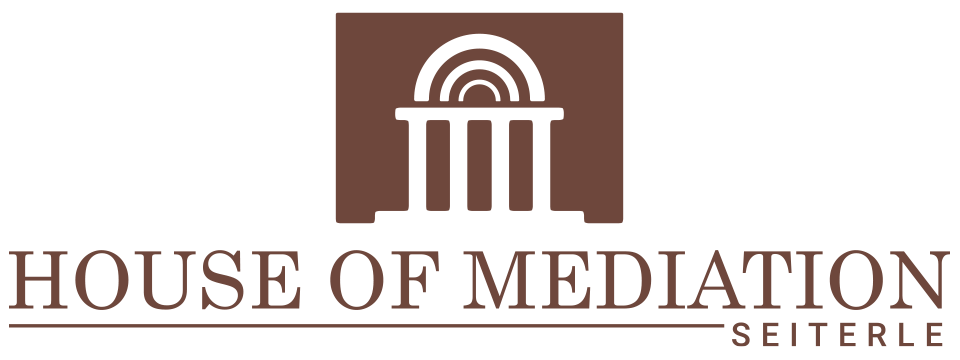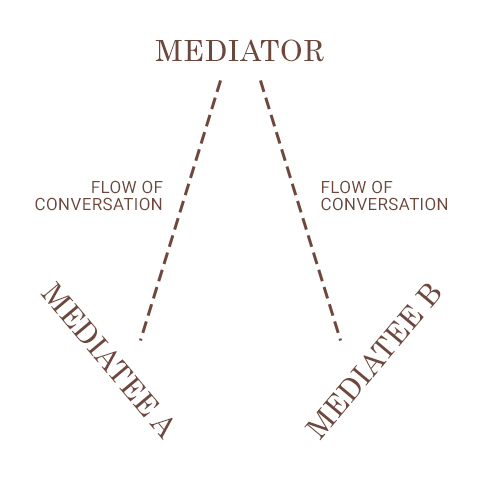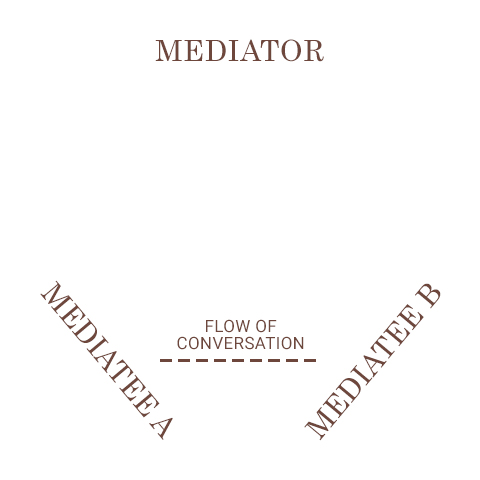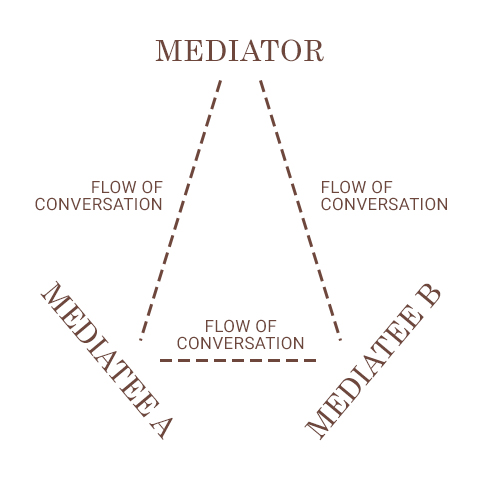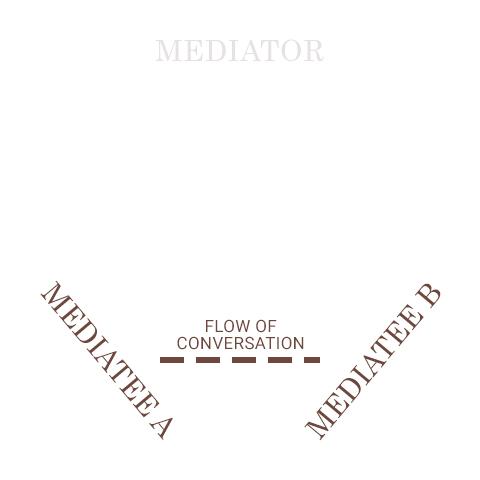Mediation
In detail and all around it

How does mediation work?
You can find a shorter overview in the FAQ. A mediation with HOUSE OF MEDIATION is conducted according to the 5-phase model.
Phase 1:
Opening
Opening in detail
In the opening phase all the parties (mediatees) and myself meet in person.
All questions, the procedure, the characteristics of a mediation and the role of the mediator are discussed. We also agree on a culture of discussion. Confidentiality between the parties and the question of costs have usually already been clarified. If not, these questions can be addressed in this phase.
Voluntary participation in mediation and agreement to caucus (one-on-one meetings) are verified. The expectations and final organizational framework are considered. First and foremost, this phase serves to build trust with the mediator.
Phase 2:
Stock-taking
Stock-taking in detail
One after the other, the mediatees describe their view of the conflict and its cause(s).
As a mediator, I make sure that all parties get equal time to talk and that the culture of conversation is maintained. Subsequently, the mediatees formulate their issues, i.e. they name their conflict concerns in a heading.
Classic formulations are, for example, “dealing with,” “manner of,” and “future of.”
The goal of this phase is for the mediator to understand the conflict and all of its backgrounds in order to be able to view the situation in its depth from a neutral perspective, as well as to be able to conduct the proceedings in a thoughtful manner.
Phase 3:
Identification of interest
Identification of interest in detail
The headings found in the stock-taking are discussed in detail.
Particularly relevant are the motives of the individual conflict parties and their reasons for their positions: Why exactly this way and in no other way? In technical jargon, these are the interests.
The art of mediation is to determine these interests, to record them and to make them transparent for all. At the same time, and much more importantly, the mediatees dare to show their cards a little, for which they are usually rewarded only at the end of the conflict resolution.
The better, that is, the more interests are noted, the more individualized solutions can be designed in the next phase. As a mediator, I will humbly and incessantly ask “why”, “what for” and “what is the point”.
Determining interests is for me the most important phase of mediation and decisive for quality.
Phase 4:
Option development and selection
Option development in detail
In option development, business-oriented art is accomplished.
With the help of creativity techniques, such as brainstorming, card retrieval, brainwriting or scenario development, mediatees unfold their full potential and create innovative ideas for their conflict. The so-called synthesis treasure – the merging of individual interests – can be lifted here. In addition to providing creativity techniques, the mediator questions the feasibility of the plans and whether sufficient competencies are available for them.
Once the question of feasibility has been answered for all ideas, the mediator accompanies the mediatees in the selection process of their ideas and intercepts newly arising tensions. The phase ends when a solution has been found to each conflict topic.
Phase 5:
Final agreement
Final agreement in detail
In the last phase, the results are fixed and the fulfillment of expectations is checked.
In the case of a contract, a legal review by a lawyer is recommended. The mediatees may and should pat themselves on the back for the achievement of conflict clarification and resolution. An evaluation phone call or even a meeting can be arranged.
Supplementary information
Supplementary information
One-on-one meetings are classic for the phases of stock-taking and option development and selection. In particularly difficult situations, they can provide the decisive impetus.
Conversation flow
4 PHASES OF SUCCESSFUL COMMUNICATION
In theory, the flow of conversation in mediation follows the pattern shown in the diagram. In phases 1 and 2, the mediators talk exclusively to me. If necessary, I translate what is said into a more pleasant language. In phase 3, the conversation between the mediators slowly opens up. In phase 4 of the option development, I increasingly withdraw. Contrary to the diagram, in practice there is often still increased activity on the part of the mediator during option selection in particular, but that is what I am there for.

Characteristics
WHAT MAKES MEDIATION
Mediation is an empowerment-based process. There is no verdict here. Its characteristic feature is that the conflict parties find a solution themselves. The mediator provides all-partial, neutral and independent support. All-partial is to say that the mediator takes sides equally for all points of view. The mediator does not silently look on impartially, but thinks his or her way into each conflict position. This thinking is value-free for the mediator; he/she provides neutral ground for all thoughts and statements of the conflict parties. Furthermore, the mediator is free of own interests and acts independently.

Saving resources
through mediation
Mediation promotes sustainability. It dispenses with the judgment of third parties, such as a judge. Conflict solutions can therefore only be agreed by mutual consent. Mutual agreement means consensus and approval of the outcome discussed. Voluntariness ensures implementation. This can be of particular importance in cross-border conflicts.
Mediation protects relationships. The mediator protects against injury and reinforces respectful communication. Verbal attacks are prevented and appreciative statements are repeated. Mutual trust is maintained and usually strengthened. Cooperation is continued.
Conflict discussions using mediation are constructive. The procedural steps of mediation build on each other in a dynamic process. This means that relevant topics are negotiated in depth and side issues remain side issues. For example, after the first phase – building trust – the past or current situation is discussed before moving on to finding a solution. A common thread ensures that the conflict is dealt with in a goal-oriented manner.
Mediation is confidential. Before mediation begins, the persons who will take part in it are specified in the mediation agreement. Sensitive information thus remains locked behind the walls of the mediation and does not reach third parties, such as reporters and competitors. Violations may be punishable under criminal law.
Conflict resolution through mediation is effective. Mediation allocates time directly to the conflict by addressing the conflict face-to-face. Employees and managers can get on with their actual day-to-day business because they are not tied down by processes within the conflict (e.g. when communicating with law firms and courts). Corporate objectives thus remain largely unaffected by the conflict.
Mediation is efficient. Appointments can be made immediately and any costs incurred are usually shared between the parties to the conflict. This saves time and money. Resources are conserved.

Self-Empowerment
IN A MEDIATION
Mediation is open-ended. There is no guarantee of agreement. As part of the process, the parties to the conflict are always given the opportunity to actively participate. Control over the development of solutions is always in your hands, or in the hands of your representatives and employees.
In the case of a written final agreement signed by all conflict parties, each party is responsible for the content decided therein. No liability claims can be asserted. Contract law applies. In return, there is full creative freedom in the formulation of the final agreement.
Statements made in a mediation can be used indirectly to one’s own advantage, even if confidentiality has been agreed between the parties. Mediators are advised to be aware of what information they are sharing.
Deciding to mediate takes courage and participating in it is mental work. In relationship-laden conflicts, stressful situations may arise within a mediation. As a mediator, I professionally guide the parties through these situations.
FOCUS ON ALLPARTIALITY
Effectiveness of mediation
Within a mediation, a mediator takes on up to seven roles. Due to the skillful use of these roles and the process-dynamically coordinated discussion phases, a mediation has an effect on all mediatees.
By performing these roles, the mediator embodies the characteristics of mediation, that are necessary in the specific situation to promote the best outcome.
Agent of reality
Role: Developing a common baseline for the issue through e.g. caucus (one-on-one) or SWOT analysis of the current state.
Entertainer
Role: Creating a relaxed and pleasant atmosphere for the conversation by e.g. telling anecdotes, scents or room design.
Creator of options
Role: Providing creative techniques (e.g. brainstorming, card inquiry, scenario development, etc.) to find solutions.
Salesman / saleswoman
Role: Pressure and persuasion to concede by e.g. elements from game theory, presentation of alternatives or outlook on opportunities.
Translator
Role: Ensuring the flow of communication through e.g. intercultural competence, visualization of content or reduction to the essentials.
Family doctor
Role: Shaping of mutual understanding by means of e.g. change of perspective, retrospection or highlighting of appreciative statements.
Messenger
Role: Delivering and receiving offers from the parties.
How to recognize the need for mediation!
These signs indicate the need for in-house mediation.
Note: The prerequisites for participation in mediation are voluntariness¹ and a willingness to work constructively toward a solution.
Conformity
Above average conformity
Quality
Performance with room for improvement, e.g. carelessness, forgetfulness
Motivation
Lack of motivation or “working by the book”
Aggression
Passive-aggressive behavior
Slander
Slanderous statements to third parties who are not present
Absenteeism
Frequent periods of absence
¹The ordering of mediation by the employer or the written agreement to mediate from a previously concluded contract are also considered voluntary before German law.

Mediation styles
From relationship-oriented to process-oriented
Mediations can be led in diametric directions by their mediator. A distinction is made between relationship-oriented, issue-oriented and process-oriented mediators.
Relationship oriented
Mediations are primarily designed for mutual understanding and a restoration or improvement of the interpersonal relationship.
Fact-oriented
Mediations are primarily focused on reaching an agreement and protecting business interests or objects of dispute.
Process-oriented
Mixed form of relationship-oriented and issue-oriented mediation.
In our eyes this distinction is rather misleading. The duty of a mediator is and remains the interests of the parties. A good mediator will always be guided by the wishes of the parties and mediate accordingly, regardless of his or her preferences!
Worth knowing
Agreements on mediation in the event of a conflict can be integrated into any contract in a binding manner by means of a mediation clause. Further information is available from the ICC.
